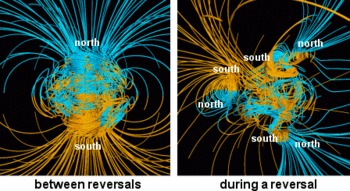magnetic field reversal

NASA computer simulation of a geomagnetic reversal. The tubes represent magnetic field lines, blue when the field points towards the center and yellow when away. The rotation axis of Earth is centered and vertical. The dense clusters of lines are within Earth's core.
Every so often, Earth's magnetic north and south poles swap places in what's known as a geomagnetic reversal. Evidence that this happens comes from the direction of magnetization in layers of iron-bearing rocks whose ages can be accurately figured out by geologists. The last time Earth's poles exchanged places was about 780,000 years ago.
Scientists aren't completely clear on why this happens. The most popular theory is that it has to do with movements in Earth's liquid iron-nickel core. The magnetic field lines in the core, it's suggested, become tangled and chaotic because of fluid motions and, from time to time, spontaneously flip into the opposite orientation. This is a slow-motion version of what happens to the Sun, whose magnetic field, as we've seen, switches direction every 11 years or so, giving rising to the sunspot cycle and the ups and downs of activity evident on the surface.
During a geomagnetic reversal, the strength of Earth's magnetic field plummets before recovering again as the new polarity asserts itself, but the details of how much the field strength falls and for how long are sketchy. According to some theoretical models, the flip might take only a year or two; other scenarios suggest a transition period lasting decades. What seems certain is that during the hiatus, Earth's surface, and any life on it, would be more exposed to the fury of the solar onslaught. For a few years, or maybe a few tens of years, we'd be bombarded by increased levels of high-energy particles normally deflected by our planet's magnetosphere.
It's troubling to learn that we've absolutely no clue when the next reversal will take place because there's no obvious pattern to past reversals. Over the course of Earth's history the geomagnetic field has flipped back and forth tens of thousands of times, but without any apparent periodicity or regularity. During a long stretch of the Cretaceous period, from 120 million to 83 million years ago, the poles stayed put. Afterwards, the frequency of reversals tended to increase, though in no predictable way. During a 12-million-year span centered about 15 million years ago there were no fewer than 51 reversals – an average of one every 235,000 years. Given that the last one we know about happened over three-quarters of a million years ago, you might suppose that we're due for another one pretty soon. But, frankly, scientists have no idea. It could start to happen later this century or in another million years time.
Even if we knew exactly what was going on in Earth's core, which we certainly don't, we wouldn't be able to forecast the next polar flip more than a decade or two in advance. To test whether we'd be able to spot a flip coming, Gauthier Hulot of Denis Diderot University in Paris, and coworkers, ran computer simulations of Earth's core based on a range of different physical conditions. They found that no matter what the input, and how precisely the starting conditions were fixed, it was impossible to tell when a polar flip would happen more than a few decades ahead of time. The process appears to be even less predictable than the long-range weather.
Of course, geophysicists nowadays keep a careful watch on what's happening to Earth's magnetic field and its poles. In recent times, the geomagnetic field has been getting weaker. Its strength has dropped between 10 and 15% over the last 150 years, and the rate of decline has sped up in the past few years. Overall, the field strength has plunged by about a third over the past couple of millennia. It's at the state now where it could potentially flip within a few thousand years. But the rate of decrease and the current strength are still within the normal range of variation, as shown by the record of past magnetic fields recorded in rocks, and it's perfectly possible that the field will strengthen again in the future rather than going into reversal.
Unlike the geographical poles (the places on the surface through which Earth's axis of rotation passes), the magnetic poles wander around. The magnetic north pole, for instance, is presently drifting from northern Canada towards Siberia at an accelerating rate – 10 km/y at the beginning of the 20th century, up to 40 km/yr in 2003, and since then at an even faster rate. But, again, there's nothing anomalous about this and we can't use it as an argument that a polar reversal imminent.
All we can confident about is that another reversal will happen sometime in the future. When it does it could be devastating given our dependence on equipment that would be rendered useless by a sudden major increase in high-energy solar radiation. Technologically, we'd be gravely affected in the interval when the geomagnetic field collapsed and the poles exchanged places. But from a biological perspective it isn't clear that we'd suffer so badly. Our ancestors, such as as Homo erectus, evidently survived previous reversals, albeit they weren't inconvenienced by breakdowns in sat-nav devices or outages in their power supply. There's also no evidence that polar flips were responsible for past mass extinctions. Life, it seems, can go on despite our planet's occasional magnetic field reversals. One possible reason is that interactions between the solar wind and Earth's ionosphere may create a sufficiently strong magnetic field to protect the surface from energetic particles even when the internally-generated field collapses. Another possibility is that Earth's field never actually vanishes during a reversal, but is sustained by lots of different poles forming chaotically until the normal two-pole configuration reasserts itself.

